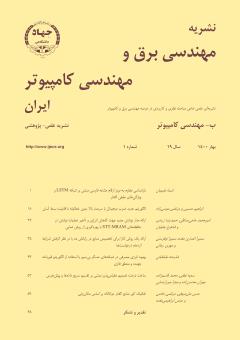بهبود انرژی مصرفی در شبكه¬هاي حسگر بي¬سيم با استفاده از الگوریتم قورباغه جهنده و منطق فازی
محورهای موضوعی : مهندسی برق و کامپیوتر
1 - مجتمع آموزش عالی سراوان
کلید واژه: شبكه حسگر بیسیم, الگوریتم قورباغه جهنده, خوشهبندی, منطق فازی, استاندارد 4/15/802 IEEE,
چکیده مقاله :
شبکههای حسگر بیسیم متشکل از هزاران گره با انرژی باتری محدود هستند و مصرف بهینه انرژی گرههای حسگر یک چالش اساسی در این نوع از شبکههاست. خوشهبندی گرههای حسگر در دستههای مجزا و تبادل اطلاعات از طریق سرخوشهها، یکی از راهکارهای بهبود مصرف انرژی است. این مقاله یک پروتکل مسیریابی مبتنی بر خوشهبندی جدید را به نام SFLCFBA ارائه میدهد. پروتکل پیشنهادی به طور بیولوژیکی از ویژگیهای جستجوی سریع و مؤثر الهامگرفته از الگوریتم قورباغه جهنده را که بر اساس رفتار غذایابی قورباغهها عمل میکند برای خوشهبندی گرههای حسگر استفاده میکند. در پروتکل پیشنهادی همچنین از منطق فازی به منظور محاسبه برازندگی گرهها، بر حسب دو معیار فاصله تا سینک و انرژی باقیمانده سطح باتری گره حسگر استفاده میشود. روش پیشنهادی در شبیهساز OPNET شبیهسازی شد و نتایج حاصل از شبیهسازی با پروتکل NODIC و استاندارد 4/15/802 IEEE مقایسه شدند. نتایج به دست آمده از شبیهسازی نشاندهنده عملکرد بهتر پروتکل پیشنهادی از نظر انرژی سطح باتری، نسبت سیگنال به نویز، تأخیر انتها به انتها و میزان بستههای تحویلشده به ایستگاه پایه یا سینک میباشد.
Wireless sensor networks consist of thousands of sensor nodes with limited energy. Energy efficiency is a fundamental challenge issue for wireless sensor networks. Clustering sensor nodes in separate categories and exchanging information through clusters is one of the ways to improve energy consumption. This paper presents a new cluster-based routing protocol called SFLCFBA. The proposed protocol biologically uses fast and effective search features inspired by the Shuffled Frog Leaping algorithm, which acts based on the Frog food behavior to cluster sensor nodes. The proposed protocol also uses fuzzy logic to calculate the node fitness, based on the two criteria of distance to the sink and the remaining energy of the sensor node or power of battery level. IEEE 802.15.4 Protocol and NODIC Protocol with the proposed methodology and OPNET Simulator were simulation and the results in terms of energy consumption, end to end delay, signal to noise ratio, the success property data and throughput were compared with each other. The results of the simulation showed that the proposed method outperforms the IEEE 802.15.4 Protocol and NODIC Protocol due to the use of the criteria listed.
[1] K. Romer and F. Mattern, "The design space of wireless sensor networks," IEEE Wireless Communications, vol. 11, no. 6, pp. 54-61, Dec. 2004.
[2] B. Baranidharan, S. Srividhya, and B. Santhi, "Energy efficient hierarchical unequal clustering in wireless sensor networks," Indian J. Sci Technol, vol. 7, no. 3, pp. 301-305, Apr. 2014.
[3] S. Tabatabaei and A. M. Rigi, "Reliable routing algorithm based on clustering and mobile sink in wireless sensor networks," Wireless Personal Communications, vol. 108, no. 4, pp. 2541-2558, May 2019.
[4] S. Radhika and P. Rangarajan, "On improving the lifespan of wireless sensor networks with fuzzy based clustering and machine learning based data reduction," Applied Soft Computing, vol. 83, Article No.: 105610, Oct. 2019.
[5] M. Fyffe, M. T. Sun, and X. Ma, "Traffic-adapted load balancing in sensor networks employing geographic routing," in Proc. IEEE Wireless Communications and Networking Conf., WCNC’07, pp. 4389-4394, Hong Kong, China, 11-15 Mar. 2007.
[6] R. Logambigai, S. Ganapathy, and A. Kannan, "Energy-efficient grid-based routing algorithm using intelligent fuzzy rules for wireless sensor networks," Computers & Electrical Engineering, vol. 68, pp. 62-75, 2018.
[7] M. Arghavani, M. Esmaeili, M. Esmaeili, F. Mohseni, and A. Arghavani, "Optimal energy aware clustering in circular wireless sensor networks," Ad Hoc Networks, vol. 65, pp. 91-98, Oct. 2017.
[8] S. Tabatabaei, A. Rajaei, and A. M. Rigi, "A novel energy-aware clustering method via lion pride optimizer algorithm (LPO) and fuzzy logic in wireless sensor networks (WSNs)," Wireless Personal Communications, vol. 108, pp. 1803-1825, 2019.
[9] A. Shelebaf and S. Tabatabaei, "A novel method for clustering in WSNs via TOPSIS multi-criteria decision-making algorithm," Wireless Personal Communications, vol. 112, pp. 985-1001, 2020.
[10] R. Singh and A. K. Verma, "Energy efficient cross layer based adaptive threshold routing protocol for WSN," AEU-International J. of Electronics and Communications, vol. 72, pp. 166-173, Feb. 2017.
[11] D. R. Chen, L. C. Chen, M. Y. Chen, and M. Y. Hsu, "A coverage-aware and energy-efficient protocol for the distributed wireless sensor networks," Computer Communications, vol. 137, pp. 15-31, 2019.
[12] M. Wang, S. Wang, and B. Zhang, "APTEEN routing protocol optimization in wireless sensor networks based on combination of genetic algorithms and fruit fly optimization algorithm," Ad Hoc Networks, vol. 102, Article No.: 102138, 1 May 2020.
[13] W. Rehan, S. Fischer, M. Rehan, Y. Mawad, and S. Saleem, "QCM2R: a QoS-aware cross-layered multichannel multisink routing protocol for stream based wireless sensor networks," J. of Network and Computer Applications, vol. 156, Article No.: 102552, 15 Apr. 2020.
[14] N. P. Mahalik, Sensor Networks and Configuration, Springer, 2007.

